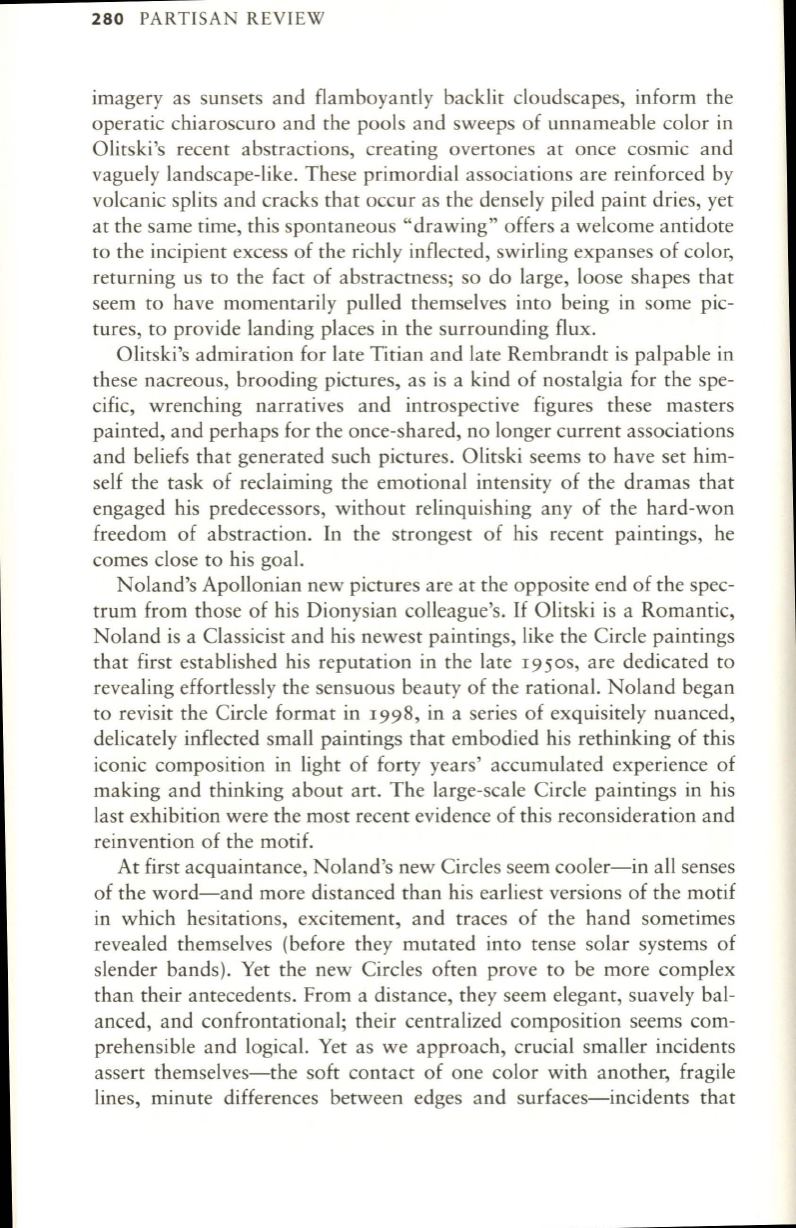
280
PARTISAN REVIEW
imagery as sunsets and flamboyantly backlit c1oudscapes, inform the
operatic chiaroscuro and the pools and sweeps of unnameable color in
Olitski's recent abstractions, creating overtones at once cosmic and
vaguely landscape-like. These primordial associations are reinforced by
volcanic splits and cracks that occur as the densely piled paint dries, yet
at the same time, this spontaneous "drawing" offers a welcome antidote
to
the incipient excess of the richly inflected, swirling expanses of color,
returning us
to
the fact of abstractness; so do large, loose shapes that
seem to have momentarily pulled themselves into being in some pic–
tures,
to
provide landing places in the surrounding flux.
Olitski's admiration for late Titian and late Rembrandt is palpable in
these nacreous, brooding pictures, as is a kind of nostalgia for the spe–
cific, wrenching narratives and introspective figures these masters
painted, and perhaps for the once-shared, no longer current associations
and beliefs that generated such pictures. Olitski seems to have set him–
self the task of reclaiming the emotional intensity of the dramas that
engaged his predecessors, without relinquishing any of the hard-won
freedom of abstraction.
In
the strongest of his recent paintings, he
comes close to his goal.
Noland's Apollonian new pictures are at the opposite end of the spec–
trum from those of his Dionysian colleague's.
If
Olitski is a Romantic,
Noland is a Classicist and his newest paintings, like the Circle paintings
that first established his reputation in the late
I950S,
are dedicated to
revealing effortlessly the sensuous beauty of the rational. Noland began
to revisit the Circle format in
I998,
in a series of exquisitely nuanced,
delicately inflected small paintings that embodied his rethinking of this
iconic composition in light of forty years' accumulated experience of
making and thinking about art. The large-scale Circle paintings in his
last exhibition were the most recent evidence of this reconsideration and
reinvention of the motif.
At first acquaintance, Noland's new Circles seem cooler-in all senses
of the word-and more distanced than his earliest versions of the motif
in which hesitations, excitement, and traces of the hand sometimes
revealed themselves (before they mutated into tense solar systems of
slender bands). Yet the new Circles often prove
to
be more complex
than their antecedents. From a distance, they seem elegant, suavely bal–
anced, and confrontational; their centralized composition seems com–
prehensible and logical. Yet as we approach, crucial smaller incidents
assert themselves-the soft contact of one color with another, fragile
lines, minute differences between edges and surfaces-incidents that


